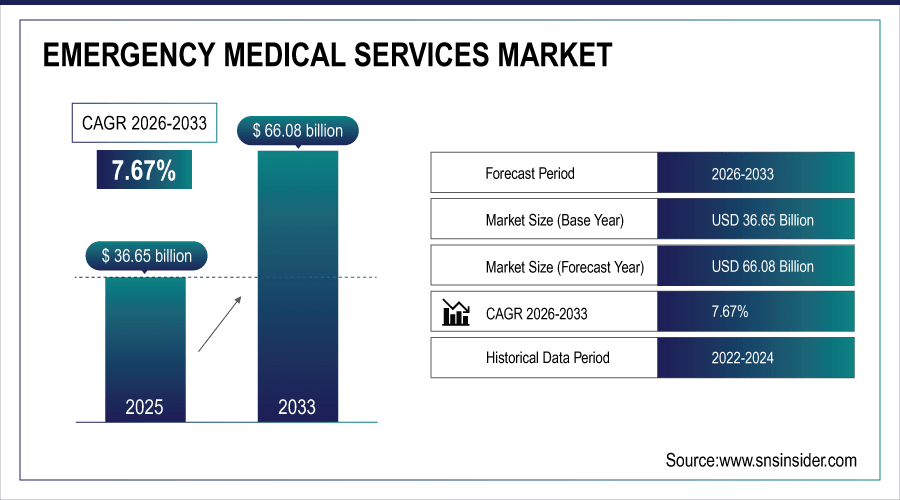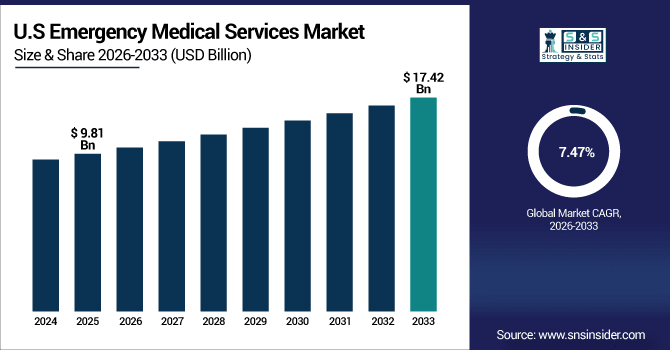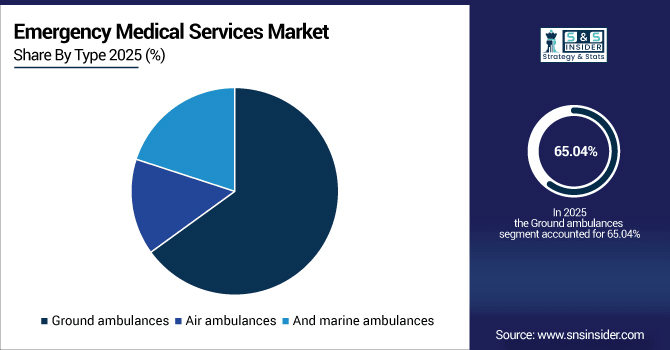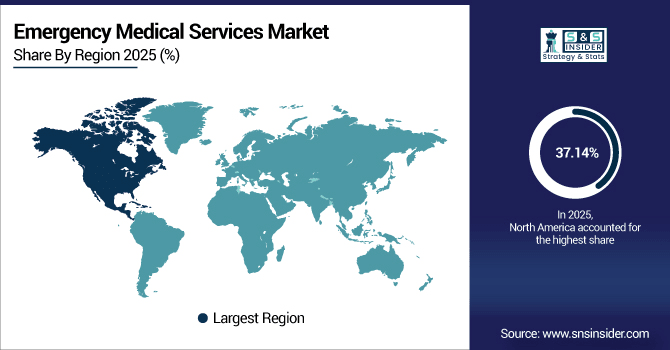Emergency Medical Services Market Size Analysis:
The Emergency Medical Services Market Size was valued at USD 36.65 Billion in 2025E and is expected to reach USD 66.08 Billion by 2033 and grow at a CAGR of 7.67% over the forecast period 2026-2033.
The Emergency Medical Services Market analysis, driven by the rising incidence of trauma and accident cases, along with the growing prevalence of emergency medical cases. Urban densification and drive-by traffic increase accentuate the need for prompt availability of EMS. According to study, Globally, over 1.3 million people die each year in road traffic accidents, and 20–50 million sustain non-fatal injuries, creating a large demand for EMS services.

To Get More Information On Emergency Medical Services Market - Request Free Sample Report
Market Size and Forecast:
-
Market Size in 2025: USD 36.65 Billion
-
Market Size by 2033: USD 66.08 Billion
-
CAGR: 7.67% from 2026 to 2033
-
Base Year: 2025
-
Forecast Period: 2026–2033
-
Historical Data: 2022–2024
Emergency Medical Services Market Trends
-
Rapid urbanization increases demand for timely emergency medical response services globally.
-
Adoption of AI-based triage and telemedicine enhances EMS operational efficiency.
-
Rising public awareness boosts utilization of EMS for critical medical emergencies.
-
Expansion of EMS coverage in rural areas addresses healthcare accessibility gaps.
-
Government and private investments drive modernization of ambulances and EMS infrastructure.
-
Mobile and air EMS units are increasingly deployed for hard-to-reach locations.
U.S. Emergency Medical Services Market Insights
The U.S. Emergency Medical Services Market size was USD 9.81 Billion in 2025E and is expected to reach USD 17.42 Billion by 2033, growing at a CAGR of 7.47% over the forecast period of 2026-2033, driven by robust healthcare systems, widespread ambulance networks, and high public awareness of emergency care. Continuous investments in advanced technologies, rapid response initiatives, and well-trained personnel strengthen service efficiency and ensure comprehensive coverage across urban and rural areas.

Emergency Medical Services Market Growth Drivers:
-
Rising Emergencies Boost Demand for Faster, Efficient Emergency Medical Services
Emergency Medical Services Market growth is driven by the rising number of road traffic accidents, workplace injuries, and sudden medical emergencies such as cardiac arrests, strokes, and respiratory failures. Rapid urbanization and growing population density in cities further exacerbate the need for timely emergency response. EMS providers are increasingly adopting advanced technologies such as AI-based triage, GPS tracking, and telemedicine, which enhance operational efficiency and improve patient survival rates. This trend ensures a steady and growing demand for EMS services globally.
Among EMS calls, trauma-related emergencies account for nearly 35–40%, while cardiac and respiratory emergencies make up 20–25% of total calls.
Emergency Medical Services Market Restraints:
-
High Operational Costs Limit Expansion and Accessibility of EMS Services
The Emergency Medical Services Market has been facing significant risk due to the cost involved in installation and maintenance of emergency services. Fixed-wing air ambulances, comprehensive trauma care units, and specialized medical equipment such as ventilators, defibrillators, and monitors imply enormous capital investments. Facility costs, fuel, payroll and ongoing training of paramedics and EMTs also contribute to the financial strain. In low resource or rural settings, such costs might restrict access to and quality of EMS. Thus, a lot of small or independent providers not have the scale to operate more broadly and in more marginal markets, constraining total market expansion.
Emergency Medical Services Market Opportunities:
-
Expanding EMS Reach to Rural Areas Unlocks Significant Market Potential
The significant growth opportunity in extending Emergency Medical Services coverage to rural and remote regions where access to healthcare facilities is limited. Governments, and private players, are pumping in funds to develop mobile EMS units’ telemedicine enabled ambulances and helicopters to connect hard-to-reach areas. The expansion of rural Emergency Medical Services involved in both unmet medical need of crusher of the damage and disease due to trauma and emergencies. Increased consciousness about emergency care, convenient policies and technology-enabled solutions will mean greater acceptance of the kits in rural markets and hold out a promising prospect for market extensions.
Governments and private players are increasing investment, with over 25–30% of new EMS units dedicated to rural or remote regions.
Emergency Medical Services Market Segmentation Analysis:
-
By Type: In 2025, Ground ambulances led the market with a share of 65.04%, while Air ambulances is the fastest-growing segment with a CAGR of 10.50%.
-
By Application: In 2025, Trauma care led the market with a share of 40.50%, while Cardiac care is the fastest-growing segment with a CAGR of 9.20%.
-
By Ownership: In 2025, Private services led the market with a share of 45.14%, while Volunteer services is the fastest-growing segment with a CAGR of 11.20%.
-
By End-User: In 2025, Hospitals & Clinics led the market with a share of 50.04%, while Remote & Rural Communities is the fastest-growing segment with a CAGR of 10.80%.
By Type, Ground Ambulances Lead Market and Air Ambulances Fastest Growth
The Ground ambulances lead the market in 2025, due to their wide availability, low cost and high operation flexibility during urban and rural duties. They are commonly employed for accident attendance and patient transport, and individuals who require medical attention and support. In Meanwhile, Air Ambulances is the fastest growing segment, benefiting from increasing need of quick critical care movement and advance life support facility. Their growing use in remote and high-traffic areas, and technological improvements such as real-time communication and telemedicine support, are promoting their acceptance. Although necessary for coastlines, marine ambulances continue to be a smaller but important part of EMS services.

By Application, Trauma Care Lead Market and Cardiac Care Fastest Growth
The Trauma care lead the market in 2025, owning to heavily contributes to increasing number of road accidents, workplace injuries and emergencies that require immediate medical aid. Specialist trauma units and rapid response protocols support this influence. In Meanwhile, Cardiac Care is becoming the fastest growing segment due to increasing global prevalence of heart diseases and awareness among people towards cardiac emergency maintenance. Advancements in monitoring product systems, early intervention devices and remote cardiac diagnostic offerings also are helping to drive growth within this segment, while the respiratory market is continuing an incremental expansion across large healthcare systems.
By Ownership, Private Services Lead Market and Volunteer Services Fastest Growth
The Private services lead the market in 2025, due to their effective operations and superior infrastructure and strong relationships with local hospital and insurance companies. Private providers also have better-equipped ambulances and faster response times, prompting urban populations to Favor them. In Meanwhile, Volunteer Services surge fastest growing segment for community-run and non-profit organization life lines in underserved rural areas. The increasing focus on social responsibility in healthcare and training for volunteers is promoting more participation, and is accompanied by the continued support of public EMS organizations and hospital-based systems.
By End-User, Hospitals & Clinics Lead Market and Remote & Rural Communities Fastest Growth
The Hospitals & Clinics leads the market in 2025, due Vital link between emergency response and definitive patient care. As we become busier their reliance on EMS for critical patient transfers and trauma stabilization will make them top revenue generator. Meanwhile, Remote & Rural Communities, is anticipated to grow at the fastest pace due to increasing healthcare availability in remote areas through mobile EMS units, helicopter ambulances, and digital health solutions. Increasing emphasis on decreasing mortality rates in rural areas and enhanced response times is inspiring EMS expansion in these regions, emerging as a key focus area for market participants globally.
Emergency Medical Services Market Regional Analysis:
North America Emergency Medical Services Market Insights:
The North America dominated the Emergency Medical Services Market in 2025E, with over 37.14% revenue share, driven by highly consolidated on account of its strong healthcare infrastructure, and integrated health and safety solutions resulting in increased deployment of latest real-time emergency response technologies such as AI driven dispatch and telemedicine integration. The overall quality of EMS services is improved by good regulatory systems, effective communication systems, and ample investment in modernizing ambulance fleets.

Get Customized Report as Per Your Business Requirement - Enquiry Now
U.S. Emergency Medical Services Market Insights
The U.S. and Canada lead the Emergency Medical Services market due to Highly developed healthcare infrastructure, well-established government funding throughout the region, and early adoption of technological advancements such as an AI based dispatch system and telemedicine. High number of accidents, trained professionals and established structure for emergency response add to the efficiency and reliability levels, contributing towards regional market dominance.
Asia Pacific Emergency Medical Services Market Insights:
The Asia-Pacific region is expected to have the fastest-growing CAGR 8.89%, due to urbanization, growth of accidents and increased health care investment. Increasing acknowledgment regarding early medical intervention along with rising healthcare infrastructure in emerging economies will drive the market. Investments in EMS are being made by governments to enhance service delivery, utilize public-private partnership and integrated systems of telemedicine to increase access by rural and remote populations. Response efficiency is also being improved with technology such as GPS-enabled ambulances and AI-based triage systems.
China and India Emergency Medical Services Market Insights
China and India are witnessing rapid growth in the Emergency Medical Services market due to rising healthcare investments, increasing urbanization, and growing awareness of timely medical response. Expanding road networks, higher accident rates, and government initiatives to improve rural EMS infrastructure are further accelerating market development in both countries.
Europe Emergency Medical Services Market Insights
Europe Emergency Medical Services (EMS) Market is growing at a steady pace due to the developed healthcare infrastructure, strong government policies and uniform pre-hospital patient care in the region. The deployment of cutting-edge technologies - such as AI-supported diagnostics, telemedicine and fully integrated communications systems, will ensuring high levels of operational efficiency and patient care. Growing numbers of geriatric and chronically, cardiovascular disease populations are also adding to EMS demand.
Germany and U.K. Emergency Medical Services Market Insights
Germany and U.K. are growing steadily owing to well-established healthcare systems, solid regulatory impositions and sustained modernization of ambulance fleets. The growing aged population, chronic diseases and digital health technology between both countries has enhanced EMS effectiveness to serve the population.
Latin America (LATAM) and Middle East & Africa (MEA) Emergency Medical Services Market Insights
The Latin America (LATAM) and Middle East & Africa (MEA) Emergency Medical Services (EMS) Market is experiencing a growing trend as the countries of these regions are slowly developing their healthcare infrastructure, investing more on ambulances and striving to raise awareness with respect to the accessibilities towards emergency care. Urbanization and government programs supporting improvements in the pre-hospital care are driving the adoption of EMS, primarily in urban settings, around the LATAM region. Meanwhile, in MEA, the expansion of private healthcare service providers, growing road accidents and demand for advanced life support ambulances are driving growth.
Emergency Medical Services Market Competitive Landscape
GE Healthcare contributes to the Emergency Medical Services Market through innovations like the AI-powered Command Center, which forecasts hospital census and resource requirements. This enhances EMS coordination, reduces delays, and improves patient care during emergencies. By integrating advanced analytics, telemedicine, and operational management tools, GE Healthcare supports emergency medical teams in delivering faster, more efficient, and technology-enabled services across healthcare networks.
-
In July 2025, GE Healthcare launched its Command Center, utilizing AI-driven census forecasting and staffing solutions to enhance hospital resource prediction and optimize emergency medical services. The platform also supports real-time decision-making, improving operational efficiency across EMS networks.
Medtronic is shaping the Emergency Medical Services Market with intelligent patient monitoring solutions like HealthCast™, integrating AI and real-time data analytics. These technologies facilitate early intervention during critical emergencies and optimize emergency response workflows. By improving the accuracy of patient monitoring and supporting life-saving decisions, Medtronic strengthens the efficiency and reliability of EMS operations, enhancing healthcare delivery in urban and rural areas.
-
In May 2025, Medtronic's HealthCast™ intelligent patient monitoring system won the 2025 MedTech Breakthrough Award for 'Best Overall Medical Device Solution,' recognizing its impact on emergency medical services through advanced monitoring capabilities.
Cardinal Health is enhancing the Emergency Medical Services Market through advanced patient monitoring systems, such as the Kendall DL™ Multi System, which enables continuous vital sign tracking. By providing innovative medical devices and streamlined solutions, Cardinal Health supports faster emergency response, improved patient outcomes, and operational efficiency for EMS providers. Their focus on safety and technology-driven care strengthens EMS capabilities across hospitals and remote regions.
-
In June 2025, Cardinal Health launched the Kendall DL™ Multi System, a device enabling continuous monitoring of vital signs, streamlining patient care in emergency medical services. This innovation aims to reduce response times and improve patient outcomes in critical situations.
Emergency Medical Services Market Key Players:
Some of the Emergency Medical Services Market Companies are:
-
Medtronic plc
-
Stryker Corporation
-
3M Company
-
Cardinal Health, Inc.
-
Philips Healthcare
-
BD (Becton, Dickinson and Company)
-
Medline Industries, Inc.
-
Smiths Medical
-
ZOLL Medical Corporation
-
Johnson & Johnson Services, Inc.
-
Laerdal Medical
-
Teleflex Incorporated
-
B. Braun Melsungen AG
-
Asahi Kasei Corporation
-
Smith & Nephew plc
-
C. R. Bard, Inc.
-
Terumo Corporation
-
ConvaTec Inc.
| Report Attributes | Details |
|---|---|
| Market Size in 2025E | USD 36.65 Billion |
| Market Size by 2033 | USD 66.08 Billion |
| CAGR | CAGR of 7.67% From 2026 to 2033 |
| Base Year | 2025E |
| Forecast Period | 2026-2033 |
| Historical Data | 2022-2024 |
| Report Scope & Coverage | Market Size, Segments Analysis, Competitive Landscape, Regional Analysis, DROC & SWOT Analysis, Forecast Outlook |
| Key Segments | • By Type (Ground ambulances, Air ambulances, Marine ambulances) • By Application (Trauma care, Cardiac care, Respiratory care, Others) • By Ownership (Private services, Government services, Hospital owned services, Volunteer services, Others) • By End-User (Hospitals & Clinics, Public Safety & Law Enforcement, Corporate & Industrial Facilities, Event & Entertainment Venues, Remote & Rural Communities) |
| Regional Analysis/Coverage | North America (US, Canada), Europe (Germany, UK, France, Italy, Spain, Russia, Poland, Rest of Europe), Asia Pacific (China, India, Japan, South Korea, Australia, ASEAN Countries, Rest of Asia Pacific), Middle East & Africa (UAE, Saudi Arabia, Qatar, South Africa, Rest of Middle East & Africa), Latin America (Brazil, Argentina, Mexico, Colombia, Rest of Latin America). |
| Company Profiles | GE Healthcare, Medtronic plc, Stryker Corporation, 3M Company, McKesson Corporation, Cardinal Health, Inc., Philips Healthcare, BD (Becton, Dickinson and Company), Medline Industries, Inc., Smiths Medical, ZOLL Medical Corporation, Johnson & Johnson Services, Inc., Laerdal Medical, Teleflex Incorporated, B. Braun Melsungen AG, Asahi Kasei Corporation, Smith & Nephew plc, C. R. Bard, Inc., Terumo Corporation, ConvaTec Inc., and Others. |

